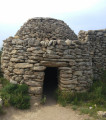Refine your search for walks in Istres
Istres walks
 The Étang de l'Olivier
The Étang de l'Olivier
A lovely route around the Étang de l'Olivier lake near the town of Istres.
 Le Barabant and Saint-Étienne hill
Le Barabant and Saint-Étienne hill

A short hike above Istres with views of the Étang de Berre and La Crau.
 The Caderaou Balcony (le balcon de Caderaou)
The Caderaou Balcony (le balcon de Caderaou)

A hike along the balcony with superb views of the Etang de Berre (a small inland sea called Lake Berre).
 The Engrenier and Pourra ponds
The Engrenier and Pourra ponds

A beautiful hike in the Saint-Blaise area, near Fos-sur-Mer, around the ponds of Lavalduc, Citis, Pourra and Engrenier.
⚠️ 29/04/2024: hike modified to avoid the path that runs along the Martigues canal beside the Lavaduc pond on the edge of the cliff (private site).
 The oppidum of Saint-Blaise
The oppidum of Saint-Blaise

Stroll across the Castillon plateau to discover one of the Mediterranean's major archaeological sites and its surroundings, which include four ponds.
 Little Camargue
Little Camargue

A short walk in a protected area on the edge of the Étang de Berre and its industries. All the vegetation of the wetlands, birds galore.
Moderator's note Please note that part of this loop is closed between April and July. See notices.
 Circular of Cabasse and Belval plain
Circular of Cabasse and Belval plain

This easy, mostly shaded hike takes just over 3 hours and will allow you to discover the Cabasse and Belval plains as well as the Collet de la Garde with its 360° panoramic view. Along the way, you will discover the restored Jas du Pape sheepfold with its enclosure and well, evidence of pastoral activity in the hills. You will also walk alongside the medieval Pougnois Canal, dug in the 11th century by the monks of Montmajour Abbey.
 Château de Fos-sur-Mer and Étang de l'Estomac
Château de Fos-sur-Mer and Étang de l'Estomac

This hike offers striking contrasts between the historic centre of Fos-sur-Mer with its Hauture hilltop castle on one side, the Étang de l'Estomac lagoon and former Fos salt marshes on the other, and the surrounding industrial activity characterised by the numerous oil tankers in the nearby Gulf of Fos.
Information panels will help you discover the history of the former salt marshes.
 Touloubre Gorges, hilltop village and dry stone walls
Touloubre Gorges, hilltop village and dry stone walls

This varied and easy loop takes you to the village of Cornillon-Confoux, one of the most beautiful hilltop villages in Provence. The village, with its stone houses and cobbled streets, offers exceptional views on both sides.The site of Cornillon, steeped in history, has been inhabited since Neolithic times.In the surrounding area, you will discover many traces of a farming and pastoral past.
 Figuerolles loop
Figuerolles loop

Nature walk to discover the agricultural heritage of the Grand Parc de Figuerolles. Loop that allows you to walk along the Étang de Berre.
 The drystone shelters and the bee wall in Cornillon Confoux
The drystone shelters and the bee wall in Cornillon Confoux

During this very easy walk on flat ground alternating between tracks and small roads, you can admire beautiful drystone shelters and a bee wall.
Drystone shelters are huts built from dry stones that served as temporary dwellings for farmers in Provence in the 19th century. The bee wall, or Apier, is an 18th-century dry stone wall, 60 metres long, with 56 niches (originally 200) where beekeepers used to shelter their straw hives from the mistral wind and bad weather.
 The hills of Grans
The hills of Grans

A walk to discover bories (dry-stone huts), perfect for a little mountain biking special, alternating between false-flat single trails (be careful of the trees!) and wide rolling tracks to get your heart pumping or to work on your endurance.
 The plains and beautiful landscape of Berre-l'Étang
The plains and beautiful landscape of Berre-l'Étang

This nearly 9 km hike starting from the Berre-l'Étang cooperative offers a beautiful immersion in the heart of varied and peaceful natural landscapes. With a very low elevation gain of 7 m, this loop is accessible to everyone, young and old, regardless of your level of fitness.
The route starts at the cooperative car park (cooperative roundabout) and quickly leads you to flat paths surrounded by plains and unspoilt natural areas. You can enjoy the vast expanses typical of the region, walking along the lake with its reflections changing throughout the day.
 Walk in the hills of Lançon-de-Provence
Walk in the hills of Lançon-de-Provence

A gentle walk with little elevation gain, on wide, sunny tracks, among kermes oaks, pines and Provençal herbs. Views of the Étang de Berre lagoon and, at times, Montagne Sainte-Victoire.
 From Salon-de-Provence to Grans via small paths
From Salon-de-Provence to Grans via small paths
An easy walk around Grans and through the Crau Verte, avoiding busy roads as much as possible, starting from the west of Salon-de-Provence.
 The Tallagard Massif
The Tallagard Massif

Located east of Salon-de-Provence, Tallagard is a plateau that stretches towards Aurons and Vernègues and offers easy hikes. Several well-preserved drystone shelters are visible from the start of the hike. The view is pleasant, overlooking the Alpilles, Mont Ventoux, Sainte-Baume and Sainte-Victoire.
 Le Sentier des Agassons
Le Sentier des Agassons

This trail is a pleasant walk in the heart of the Tallagard massif, among olive groves, forests and heath.
 TALLAGARD: Dry stone heritage trail
TALLAGARD: Dry stone heritage trail

Interpretation trail and discovery of the agro-pastoral heritage around drystone walls and drystone shelters. Information panels along the trail explain the drystone constructions.

